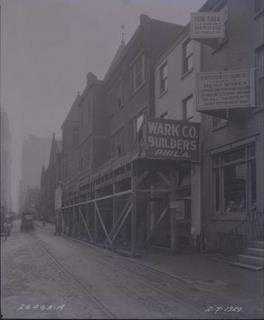

|
| 17th and Sansom Sts, 1930 |
 When Philadelphia was first imagined, it was meant to be a rural sort
of town and not a city, meant to have separations between homes and
shops. That never went quite how William Penn imagined, and
Philadelphia eventually went on to be one of the US's first major
industrial cities. Nothing quite so embraces that sense of
commercialism and industry like the Rittenhouse Square area in Center
City, a sort of commercialistic and somewhat superficial but still
very pretty and somehow endearing heart to the city of brotherly love.
When Philadelphia was first imagined, it was meant to be a rural sort
of town and not a city, meant to have separations between homes and
shops. That never went quite how William Penn imagined, and
Philadelphia eventually went on to be one of the US's first major
industrial cities. Nothing quite so embraces that sense of
commercialism and industry like the Rittenhouse Square area in Center
City, a sort of commercialistic and somewhat superficial but still
very pretty and somehow endearing heart to the city of brotherly love.
On any given day, there are hundreds of people walking the streets around there, mingling and wandering. One of them is probably me. As much as I complain about this city, I've grudgingly fallen in love with it. I enjoy the fact that, for example, walking down 17th Street, I can be sandwiched between a beautiful old church with its enormous gold and red doors and the very new Sofitel, where there seems to be an eternal search for a taxi or a cigarette. I enjoy that dichotomy, that sort of split personality that comes together somewhat but still doesn't quite gel — it's a little like Penn's vision of a rural town meets the modern sensibility of conserving space.
 But then, I guess the "modern" here isn't very modern. Examples of
the dichotomy exists throughout Philadelphia's history. Pictures from
the 1930s show high rises climbing up next to tidy townhomes that sat
near tailor shops. That high rise has since gone up; those townhomes
are now little shops; the tailor has long since closed his doors.
Things change, but the differences remain.
But then, I guess the "modern" here isn't very modern. Examples of
the dichotomy exists throughout Philadelphia's history. Pictures from
the 1930s show high rises climbing up next to tidy townhomes that sat
near tailor shops. That high rise has since gone up; those townhomes
are now little shops; the tailor has long since closed his doors.
Things change, but the differences remain.
I come from a sprawling place, so this idea of everything being located in one place still amuses me. This idea of squishing everything into one space is great. I don't have to jump in a car to get a quart of milk? I don't have to wait for my car to warm up in the dead of winter just so I can go to work? I'm sold.
By P. ALEXIS NGUYEN
Back to main page.